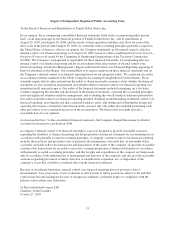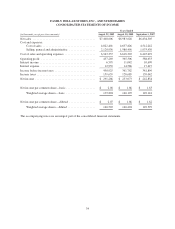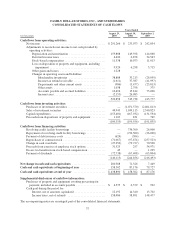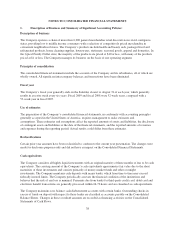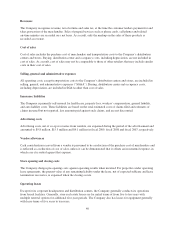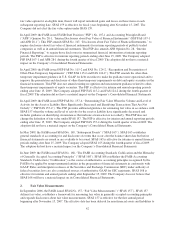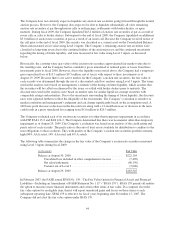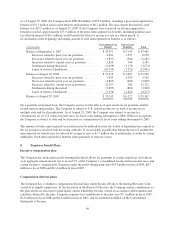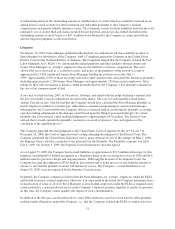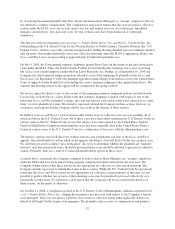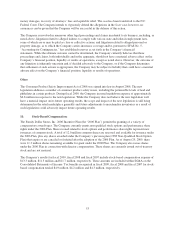Family Dollar 2009 Annual Report Download - page 51
Download and view the complete annual report
Please find page 51 of the 2009 Family Dollar annual report below. You can navigate through the pages in the report by either clicking on the pages listed below, or by using the keyword search tool below to find specific information within the annual report.
the first annual period beginning after November 15, 2008. The Company adopted SFAS 157 during the first
quarter of fiscal 2009. The adoption of SFAS 157 did not have a material impact on the Company’s Consolidated
Financial Statements. The Company does not expect the adoption of SFAS 157 with respect to non-financial
assets and liabilities during the first quarter of fiscal 2010 to have a material impact on the Company’s
Consolidated Financial Statements.
SFAS 157 defines fair value as the price that would be received to sell an asset or paid to transfer a liability in an
orderly transaction between market participants at the measurement date. SFAS 157 establishes a fair value
hierarchy which prioritizes the inputs used to measure fair value into three levels, with Level 1 being of the
highest priority.
• Level 1—Quoted prices in active markets for identical assets or liabilities.
• Level 2—Inputs other than quoted prices included within Level 1 that are observable for the asset or
liability, either directly or indirectly, such as quoted prices for similar assets or liabilities in active
markets, quoted prices for identical or similar assets or liabilities in markets that are not active, inputs
other than quoted prices that are observable for the asset or liability, or inputs that are derived
principally from or corroborated by observable market data by correlation or other means.
• Level 3—Inputs that are unobservable for the asset or liability.
The unobservable inputs in Level 3 can only be used to measure fair value to the extent that observable inputs in
Level 1 and Level 2 are not available. The following table represents the Company’s fair value hierarchy for its
financial assets that are required to be measured at fair value as of August 29, 2009:
August 29, 2009
(in thousands) Fair Value Level 1 Level 2 Level 3
Cash equivalents:
Money market funds ...................... $167,475 $167,475 $ — $ —
Investment securities:
Auction rate securities ..................... 166,545 — 3,000 163,545
Equity securities ......................... 2,801 2,801 — —
Other assets:
Mutual funds(1) .......................... 7,744 7,744 — —
Total .............................. $344,565 $178,020 $3,000 $163,545
(1) Represents assets held pursuant to a deferred compensation plan for certain key management
employees. See Note 8 below for more information.
The Company’s investment securities include student loan auction rate securities that were measured at fair value
using either Level 2 or Level 3 inputs. The auction rate securities are tax-exempt bonds that are collateralized by
federally guaranteed student loans. While the underlying securities generally have long-term nominal maturities
that exceed one year, the interest rates reset periodically in scheduled auctions (generally every 7-35 days). The
Company generally has the opportunity to sell its investments during such periodic auctions subject to the
availability of buyers.
Beginning in the second quarter of fiscal 2008, issues in the global credit and capital markets led to failed
auctions with respect to substantially all of the Company’s auction rate securities. A failed auction typically
occurs when the number of securities submitted for sale in the auction exceeds the number of purchase bids. As
of August 29, 2009, all of the Company’s $181.8 million par value investments were subject to failed auctions.
As a result of the failed auctions, the interest rates on the investments reset to the established rates per the
applicable investment offering statements. The Company will not be able to liquidate the investments until a
successful auction occurs, a buyer is found outside the auction process, the securities are called or refinanced by
the issuer, the securities are repurchased by the broker dealers, or the securities mature.
43


